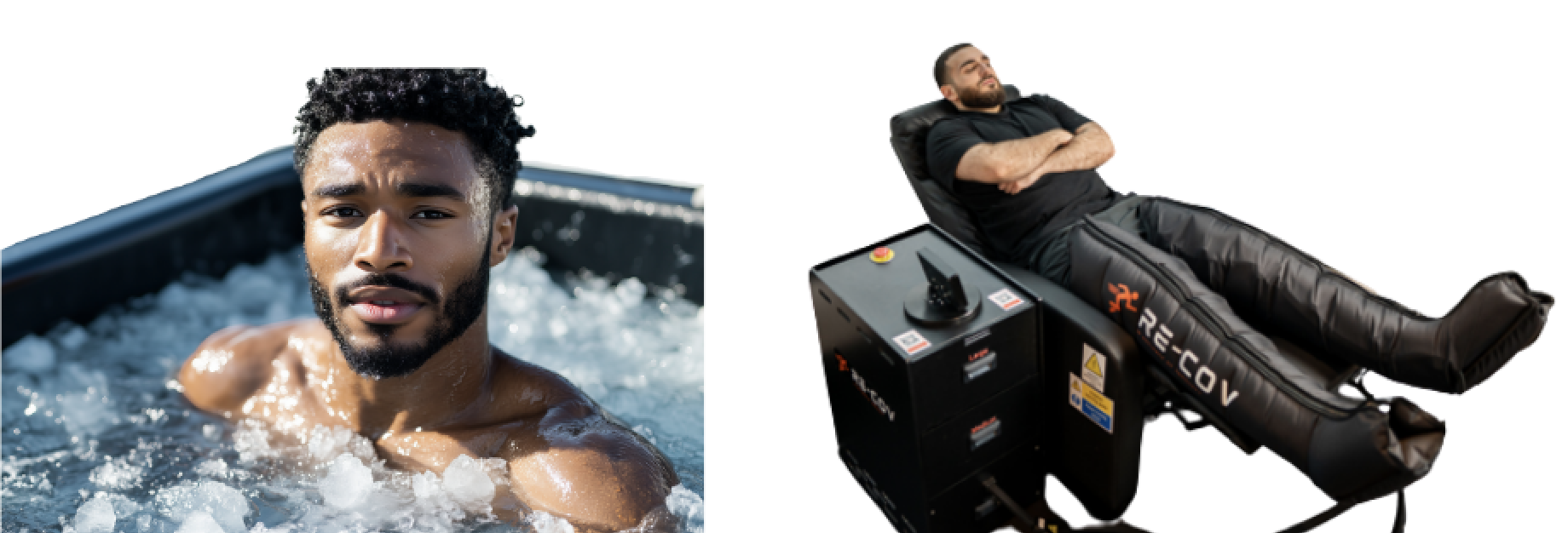
Introduction
Delayed Onset Muscle Soreness (DOMS) is a common reaction to unaccustomed or intense physical activity, typically peaking 24 to 72 hours after exercise (Cheung et al., 2003). While a normal part of muscle adaptation, DOMS can impact performance, increase injury risk, and delay recovery (Clarkson & Hubal, 2002). It is particularly prevalent after eccentric exercise, which involves muscle lengthening under tension, leading to microscopic muscle damage and subsequent inflammation (Proske & Morgan, 2001). This article explores the science behind DOMS, its causes, potential risks, and effective prevention strategies.
What Causes DOMS?
DOMS primarily results from eccentric muscle contractions, where muscles lengthen under tension, such as during downhill running or resistance training like Nordic curls or deadlifts (Cheung et al., 2003). The mechanical stress from these contractions causes microtrauma in muscle fibers, triggering an inflammatory response leading to soreness and stiffness (Clarkson & Hubal, 2002). The British Athletics Muscle Injury Classification (BAMIC) categorises DOMS as a Grade 0b muscle injury, meaning it involves generalised muscle soreness in the presence of a normal MRI, and without significant structural damage (Brukner & Khan, 2017).
Key physiological contributors to DOMS include:
- Microtrauma to muscle fibers – Small-scale muscle damage leads to localised inflammation (Nosaka et al., 2002).
- Accumulation of inflammatory markers – Sensitises pain receptors, increasing discomfort (Clarkson & Hubal, 2002).
- Fluid shifts and swelling – Contribute to muscle stiffness and tenderness (Cheung et al., 2003).
Although DOMS is not an injury itself, it can increase susceptibility to injury by:
- Reducing proprioception and muscle control – Sore muscles can impair movement coordination, increasing the likelihood of missteps and falls (Proske & Morgan, 2001).
- Altering movement patterns – To avoid discomfort, individuals may unintentionally adopt compensatory movement patterns, straining other muscles or joints (Cheung et al., 2003).
- Decreasing strength and flexibility – DOMS temporarily reduces strength and range of motion, affecting performance and increasing injury risk (Clarkson & Hubal, 2002).
Although DOMS cannot be entirely avoided, its severity can be minimized with the following strategies:
- Proper warm-up – Dynamic stretching and warm-up exercises prepare muscles for stress, reducing DOMS risk (McHugh & Cosgrave, 2010).
- Gradual progression – Slowly increasing exercise intensity allows muscles to adapt, reducing the likelihood of excessive muscle damage (Nosaka et al., 2002).
- Eccentric training adaptation – Progressive eccentric training conditions muscles to handle strain, decreasing DOMS severity over time (Hedayatpour & Falla, 2015).
- Sleep and nutrition – Adequate rest and balanced nutrition support muscle repair, reduce inflammation, and improve overall recovery (Skein et al., 2013).
- Plan your heavy leg day strategically – Eccentric-focused exercises, such as Romanian deadlifts or Nordic curls, should be completed at the start of the week if competing at the weekend. The hamstrings are particularly susceptible to DOMS. Utilize isometrics closer to competition to reduce DOMS risk (Brukner & Khan, 2017).
- Post-exercise recovery routines – Massage therapy, cold water immersion, and contrast bathing have been shown to reduce DOMS (Hing et al., 2013; Angelopoulos et al., 2022). However, these strategies are most effective when completed 2 hours after training rather than 1-2 days later when soreness peaks (Dupuy et al., 2018; Brukner & Khan, 2017).
- Intermittent Pneumatic Compression (IPC) devices, such as RE-COV Boots, have been scientifically shown to aid in post-exercise recovery through multiple mechanisms:
- Reduces Delayed Onset Muscle Soreness (DOMS) (Stedge & Armstrong, 2021).
- Provides immediate improvement in muscular fatigue (Heapy et al., 2018).
- Reduces exercise-induced stress (Collins et al., 2019; Haun et al., 2017).
- Increases anti-inflammatory markers, aiding in faster recovery (Roberts et al., 2019).
- Enhances lymphatic drainage, facilitating the removal of metabolic waste (Phillips & Gordon, 2019).
- Reduces muscle swelling, promoting better circulation and mobility (Winke & Williamson, 2018).
DOMS is a natural response to physical activity involving muscle microtrauma and inflammation. While not harmful, it can impact training and increase injury risk if not managed properly. Preventative strategies, including progressive overload, proper warm-ups, ensuring sufficient rest and nutrition, and post-workout recovery strategies, can help reduce its severity. Understanding and addressing DOMS effectively allows individuals to maintain consistent training and recovery.
Bibliography
Angelopoulos, P. et al. (2022) ‘The Effect of Cold-Water Immersion and Sports Massage on Delayed Onset Muscle Soreness in Amateur Athletes’, Healthcare, 10(12), p. 2449. DOI: 10.3390/healthcare10122449.
Brukner, P. and Khan, K. (2017) Brukner & Khan's Clinical Sports Medicine: Injuries. 5th edn. Sydney: McGraw-Hill Education.
Cheung, K., Hume, P. and Maxwell, L. (2003) ‘Delayed onset muscle soreness: Treatment strategies and performance factors’, Sports Medicine, 33(2), pp. 145-164.
Clarkson, P. M. and Hubal, M. J. (2002) ‘Exercise-induced muscle damage in humans’, American Journal of Physical Medicine & Rehabilitation, 81(11), pp. S52-S69.
Collins, R. et al. (2019) ‘Effect of External Counterpulsation on Exercise Recovery in Team Sport Athletes’, International Journal of Sports Medicine, 40(8), pp. 511-518. DOI: 10.1055/a-0923-9144.
Dupuy, O. et al. (2018) ‘An evidence-based approach for choosing post-exercise recovery techniques to reduce markers of muscle damage, soreness, fatigue, and inflammation: A systematic review with meta-analysis’, Frontiers in Physiology, 9, p. 403. DOI: 10.3389/fphys.2018.00403.
Hedayatpour, N. and Falla, D. (2015) ‘Physiological and neural adaptations to eccentric exercise: Mechanisms and considerations for training’, BioMed Research International, 2015, p. 193741.
Heapy, A. M. et al. (2018) ‘A Randomized Controlled Trial of Manual Therapy and Pneumatic Compression for Recovery from Prolonged Running – An Extended Study’, Research in Sports Medicine, 26(3), pp. 354–364. DOI: 10.1080/15438627.2018.1447469.
Hing, W. et al. (2013) ‘Contrast Water Therapy for Recovery from Sport: A Systematic Review and Meta-Analysis’, Journal of Science and Medicine in Sport, 21(1), pp. 50-56. DOI: 10.1016/j.jsams.2013.05.002.
McHugh, M. P. and Cosgrave, C. H. J. (2010) ‘To stretch or not to stretch: The role of stretching in injury prevention and performance’, Scandinavian Journal of Medicine & Science in Sports, 20(2), pp. 169-181.
Nosaka, K. et al. (2002) ‘How long does the protective effect on eccentric exercise-induced muscle damage last?’, Medicine and Science in Sports and Exercise, 33(9), pp. 1490-1495.

Leave a Comment